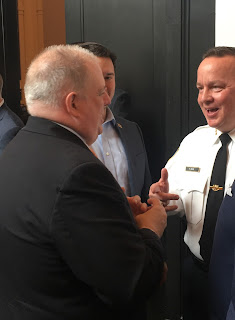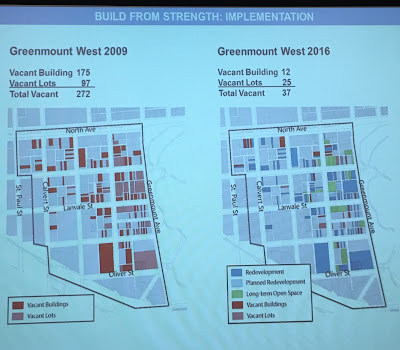 |
| Governor Hogan in conversation with Police Commissioner Davis (photo: Philipsen) |
 |
| On a big screen in a small country: Ross in Denmark |
For months Ross had dropped hints about "big plans" on his Facebook page without really indicating what he was talking about. Yet word was circulating. The blog-site Maryland Matters reported earlier this month about Ross' aspirations. Josh Kurtz reported there that Senator Ferguson had confirmed to him about Ross undertaking a serious exploration of a potential run for Governor.
When Hall started the Midday radio interview by joking about "more than one little bird telling him" that Ross may run for the office, Ross admitted on the air that he was "seriously considering" it and that a decision would be made "in a month or so". He then went on to say that he is fairly disgusted about the degree to which "Hogan is refusing to dial back Trump's reach into Maryland." His attacks on the Republicans already caused Reds Maryland, a Republican outlet to add Ross to their line-up of "Seven Domocratic Dwarfs".
 |
| Red Maryland graphic with a possible Democratic line-up |
It is interesting that Ross who speaks around the world has had only little amplication here at his home base. He had a book talk at the Pratt shortly after his book was published but has certainly not had the same media splash here that he had elsewhere.
Anybody who never heard of Ross can check him out as one of the featured speakers at Light City's EduLab at the Columbus Center, at the Inner Harbor. He and Dr. Freeman Hrabowski, president of the University of Maryland Baltimore County, will be appearing together on Wednesday April 5 and speak about “A Path to the Future” for young people.. Sessions begin at 9am.
Ross was recently featured on CSPAN speaking about his book and a wide range of ideas including education. Ross, who is originally from Charleston, WV lives and works in Baltimore. He met his wife, a teacher when teaching at Booker T Washington Middle School in Baltimore many years before he was appointed to be special adviser to the Secretary of State.
The prospect of at least two gubernatorial candidates from Baltimore City and one from Baltimore County is good news for Baltimore which has seen its political representation in Annapolis and Washington waning under the Republican wins. None of the challengers are intellectual or political dwarfs.
 |
| Ross speaking at the Pratt Library March 2016 |
The prospect of at least two gubernatorial candidates from Baltimore City and one from Baltimore County is good news for Baltimore which has seen its political representation in Annapolis and Washington waning under the Republican wins. None of the challengers are intellectual or political dwarfs.
Klaus Philipsen, FAIA
Alec Ross has written the preface to a book about Baltimore the author of this blog will publish in May
Alec Ross has written the preface to a book about Baltimore the author of this blog will publish in May
















































